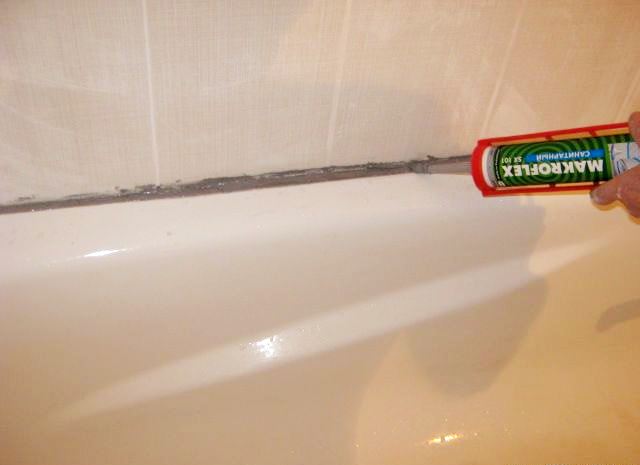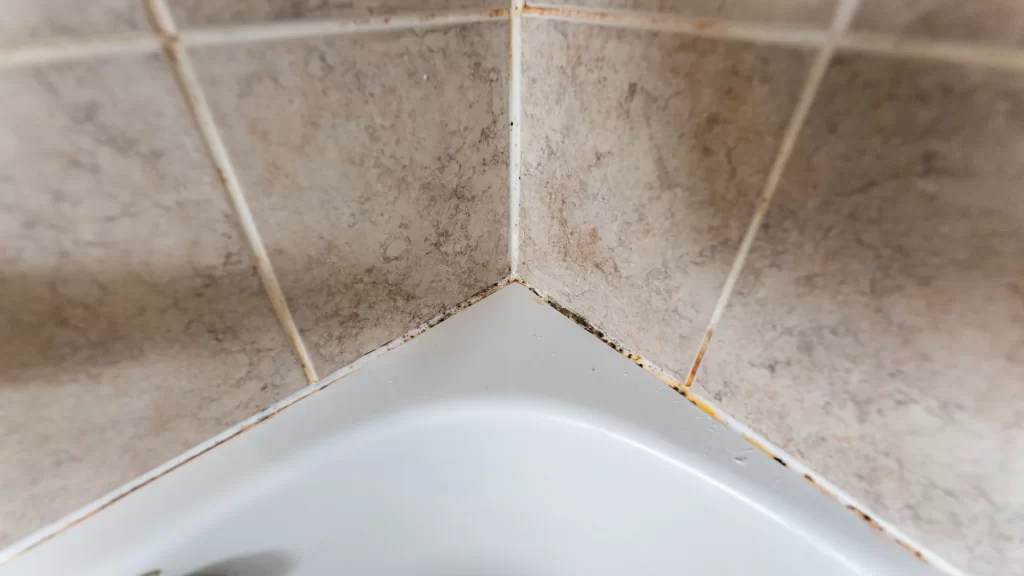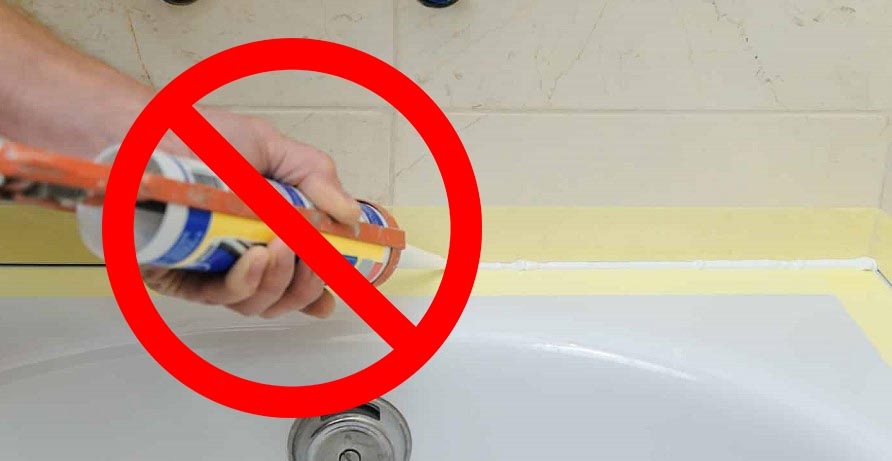If you are design-conscious and care about the appearance of your bathroom, then we suggest you read our article and learn about alternatives to caulking around the bathtub.

Reasons for replacing caulk
Next, let’s consider whether the caulk is harmful, and its effects on humans.

Toxicity
Unscrupulous manufacturers try to replace different components with cheaper ones, not caring about the health of customers.
Precautions
Uncured caulk gives off an unpleasant, vinegary, or acidic odor. Headaches may occur if inhaled for long periods of time. Accidental contact causes skin irritation.
Quality
Fillers expand and push out the plasticizer with fungicides, leading to quality deterioration and fungal growth on the treated surface.
Read also: Round vs elongated toilet: a detailed comparison of 10 important characteristics

Ways to remove old caulk
You can easily remove only fresh caulk.
The difficulty of removing the bathtub caulk depends on the composition and type of bathroom tiles.
To clean the surface of dried caulk, a combination of mechanical and chemical means are used.
Mechanical method
Tools:
- a sharp clerical;
- a blade;
- a small spatula;
- tweezers;
- flat screwdriver;
- special plastic or wooden scrapers;
- pumice stone.
Stages of doing the job:
- Beforehand, cut off the thin layers of caulk with a knife or blade. If the caulk is not very hardened, you can try to remove it in one motion.
- Grasp the incised edges with tweezers or your fingers and separate the strips and pieces of old caulk.
- Use a spatula or special scrapers (use wooden scrapers for acrylic surfaces) to remove peeling caulk.
- The thin layer of remaining caulk is very difficult to remove, but you can try to do it with fine sandpaper, a hard side of a dish sponge, or pumice stone.
- To remove the caulk from the tiles, you can rub it with an eraser or pumice stone. The eraser is especially helpful when you need to scrub embossed tile without damaging it.

Chemical methods
Since it is almost impossible to completely remove an old caulk in the bathroom by the previous method, people often supplement mechanical cleaning with chemical treatment.
When choosing a chemical product, it is important to consider the composition of the caulk.
For effective removal of acidic caulk, the active solvent must be acid, for neutral caulk, it must be gasoline or acetone.
Alternatives to caulking around the bathtub
Today, thanks to the rapid development of chemical production, there are many modern high-quality materials. They allow you to seal the seam between the bathroom and the tile quickly, without much effort.
To perform such work with your own hands, you should get acquainted with the most effective options, and consider their features.
Epoxy resin sealer
Replace caulk with an epoxy resin sealer is the simplest option for creating a watertight seal. Epoxy sealer is suitable for gaps that do not exceed 10 mm. Otherwise, you will have to apply a different method or combine the waterproof seal with other building materials (cement, construction foam, grout).
To use a bathtub sealant such as epoxy sealer, it is necessary to purchase:
- masking tape;
- solvent;
- caulk gun;
- rubber spatula;
- bathtub sealant.
Procedure:
- First, wash the working base, then degrease.
- Cover the bath and tile with paper tape, leaving a corner of 5 mm.
- Insert the tube with sealant into the caulk gun, attach the tip, and go over the joint once. A second coat is extremely undesirable. It may provoke the formation of imperfections.
- Remove the excessive mixture with a spatula or brush, pre-moistened with the soap solution.
- Carefully smooth out the surface.
- Wait 24 hours and remove the masking tape completely.
Note: during the drying of the waterproof seal, do not use the bath for its intended purpose.

Spray foam
One more caulk alternative is spray foam. It is suitable for the formation of a rough base only in cases where the gap in the area adjacent to the bathtub to the wall is no more than 30 mm.
The advantages of such a means include its ability to quickly expand and dry, unlike caulk, to the disadvantages – the difficulty of removing the excess substance from various surfaces, and hands.
Sealing the seam between the bathroom and the tiles with water-resistant spray foam requires the use of masking tape, a paper knife, and a caulk gun.
Procedure:
- Spread polyethylene on the flooring.
- Wash and then degrease the wall and the edge of the bathtub.
- Stick the masking tape near the surface to be treated.
- Wear personal protective equipment.
- Shake the can, then place it in the gun.
- Pour the spray foam into the gap and leave it to dry.
- Remove surplus foam with a knife.
- Seal the gap.
Usually, apply sealant on top of the foam, install plastic skirting boards or perform other decorative trim.

Cement mortar
People often seal the joint between the bathtub and the tile with a mixture based on cement.
Among its advantages are an affordable price, easy application, and high reliability. Of the disadvantages of such a composition, it is important to mention: the need for waterproofing, and the unsightly appearance.
For caulking holes with cement mortar, it is necessary to prepare: a mixture and a trowel. No caulking gun is required.
If the width of the gap exceeds 10 mm, install a temporary formwork: it will not allow the mass applied to fall through.
The sequence of actions:
- Thoroughly clean the surface.
- Dissolve the mixture.
- Moisten the working basis.
- Apply the mortar with a trowel.
- Wait for the material to dry completely.
- Treat the plaster layer with water-repellent impregnation.
- Place the decorative finish.
Tip: to ensure additional water flows down the wall in a room with high humidity, it is desirable to lay the cement composition at a slight angle, with tiles glued on top.

Sealant tape
Sealant tape allows you to quickly and accurately seal tiled walls. To install sealant tape, you will need only a trowel and tape roll.
Procedure:
- Wash and then degrease the surface.
- Partially remove the protective film.
- Press the edging to the wall and the bathtub with adhesive, starting from the corner. Form it with a trowel.
Tip: to increase the elasticity of the tape material, heat it with a hair dryer during installation.
Peel and stick trim
Another caulk alternative to creating a watertight seal is a sticking trim. The main advantages of modern high-quality plastic – are affordable cost, easy installation, and attractive appearance.
To perform installation work, you need to prepare: adhesive sealant, masking tape, a ruler, and a paper knife.
Procedure:
- Clean, and thoroughly degrease the surface.
- Indent the width of the edge, then glue the paper adhesive tape on the wall and the edge of the bath.
- Seal the joint with a sealant and leave it to dry completely.
- Cut stick trim of necessary size, and attach with the same sealing compound.
- Insert stopping plugs.
Note: use bath only after two days, when the adhesive dries completely.

Frequently Asked Questions
In this article, we have described the most convenient and appropriate ways to replace the old caulk in the bathroom. But if you still have doubts, we suggest you read the answers to the most common questions.
What can I use instead of caulk around a bathtub?
There are such caulk alternatives as epoxy resin sealer, grout, sealant tape, spray foam, mortar, or peel-and-stick trim.
Is caulking bathtub necessary?
The heat and humidity in the bathroom are favorable conditions for fungal growth.
To keep black, resistant mold from spreading throughout the bathroom, use silicone caulk or other caulk alternatives.
Is there an alternative to silicone sealant?
There are many alternatives to caulking around the bathtub: epoxy resin sealant, grout, sealant tape, spray foam, mortar, wall molding, professional shower corner sealant, or peel-and-stick trim.
What happens if you don’t caulk your bathtub?
In the bathroom, there are numerous seams, joints, and holes and because of the high humidity, you need to seal all these places very securely. Bathrooms are very often without windows and ventilation. As a result, moisture accumulates in the room and creates the most favorable conditions for mold.
Therefore, proper sealing of joints is also the prevention of mold in the apartment.

Conclusion
The question of how to seal the joint between the bathroom and the tile worries many people. First of all, it is necessary to carefully familiarize yourself with popular today’s methods, their main advantages and disadvantages, and then choose the most advantageous option for yourself.

